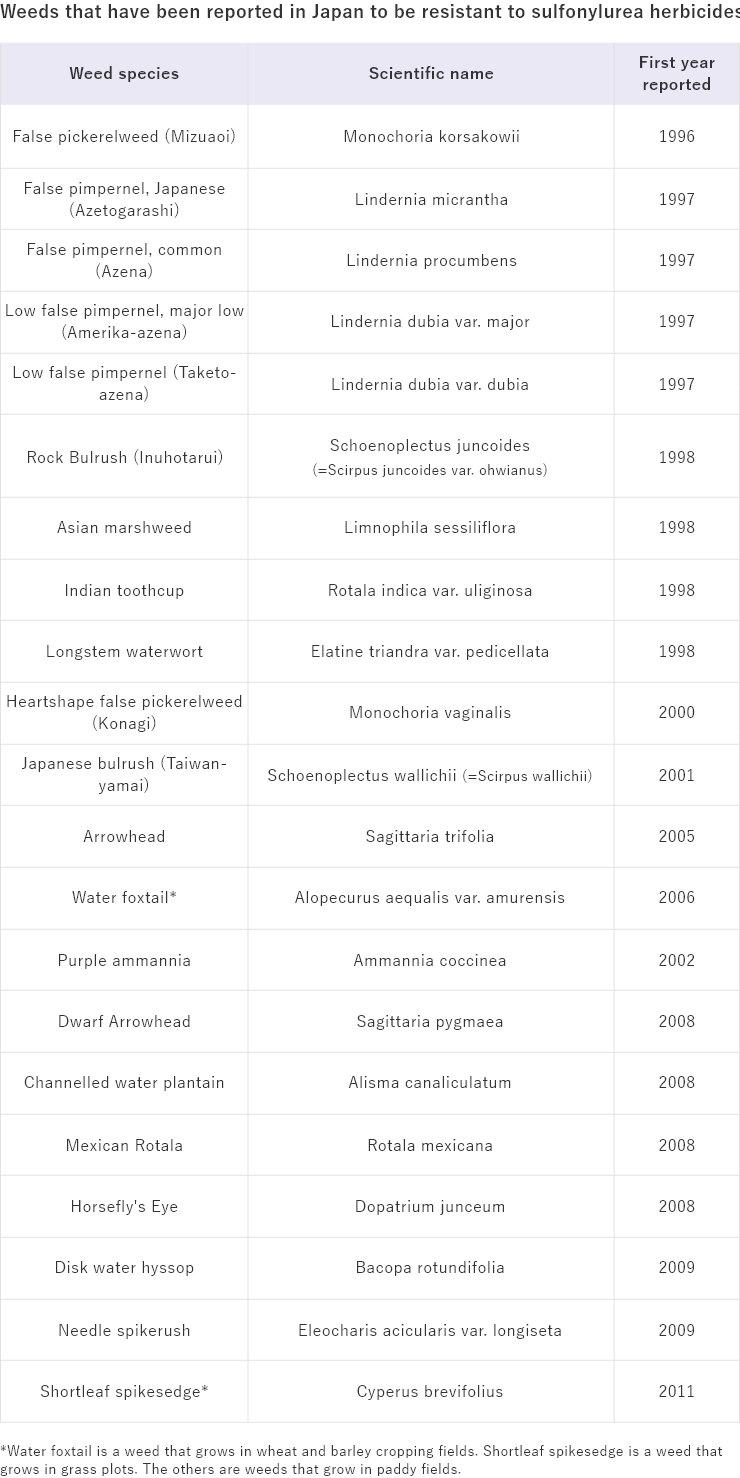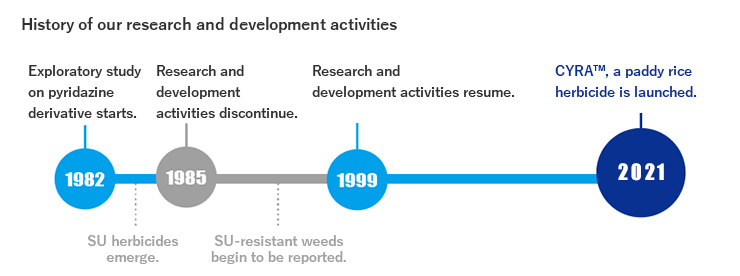Research & Development Story of CYRA™ - The Paddy Rice Herbicide that Will Greatly Contribute to Future Rice Cultivation
For rice farmers, weeds growing thick in paddy fields are nothing but obstacle. While weeds are generally controlled with herbicides, recent years have seen herbicide-resistant weeds, which are spreading across Japan.
To effectively control weeds resistant to existing herbicides, Mitsui Chemicals Crop & Life Solutions has developed CYRA. With many difficulties that we faced in the research and development of CYRA, we combined talents to create a new perspective, which has led to successful development that our team has achieved by working as one team.
This article describes the features of CYRA along with an unknown story behind the research and development of it.
Background of the Research and Development of CYRA, the Novel Herbicide That Protects Paddy Rice

One of the major crops in Japan is paddy rice. CYRA, a herbicide that we take up this time, was developed to support the production of rice, the staple food of the Japanese.
Emergence and Spread of Herbicide-resistant Weeds Growing Thick in Paddy Fields
Weeds growing in paddy fields take away nutrition that should be taken by paddy rice. They also keep sunlight out, inhibiting photosynthesis. In addition, thick weeds provide a hotbed for pests. Thus, weeds growing in paddy fields have various adverse effects on rice cultivation.
For this reason, in producing high-quality rice, it is important to control weeds growing thick in paddy fields. To control weeds in paddy fields, a herbicide is used; generally, a one-shot application herbicide is used, which is effective for a long duration and controls different types of weeds at a time.
In recent years, mixtures(※2) of sulfonylurea (SU ※1)herbicides are used in many cases. These SU herbicides effectively inhibit the activity of acetolactate synthase (ALS) in weeds. Weeds with its ALS activity inhibited cannot biosynthesize protein, which is necessary for it to grow, and will die after a while.
With a broad herbicidal spectrum (※3), SU herbicides have become widespread across Japan because of their convenience. However, with the increasing use of them, weeds resistant to SU herbicides have been reported in many places in Japan and spreading across Japan.
The following table shows a list of weeds that have been reported to be resistant to SU herbicides. For example, it is acknowledged that weeds resistant to SU herbicides include weeds that fight fierce nutrient competition with paddy rice, such as Monochoria korsakowii and Monochoria vaginalis, and weeds that are difficult to control and spread rapidly, such as Schoenoplectus juncoides and Sagittaria trifolia.

Now, novel ALS inhibitors that are also effective on SU-resistant weeds have been developed and are becoming widespread. However, weeds resistant to these new inhibitors have been already reported.
Working toward Developing Herbicides Capable of Controlling Difficult-to-control Weeds
If weeds resistant to exiting herbicides increase, great efforts and high costs are required to control them, increasing the burden of rice farmers.
In those days, there were not many effective herbicides other than SU herbicides. For this reason, many rice farmers had no choice but to rely on SU herbicides, resulting in a critical situation.
To fight against this crisis of rice cultivation, we started an exploratory study on new herbicides.
Through this exploratory study, we found a compound after clearing many hurdles; we co-worked on this compound with the National Federation of Agricultural Co-operative Associations and finally has developed CYRA. This product provides a new mode of action (※5) that has a bleaching effect (※4) on weeds. It can also control weeds resistant to SU herbicides and other ALS inhibitors.

Weeds whitened by CYRA
Unknown Story behind Research and Development of CYRA, the Paddy Rice Herbicide
We have a history of having been conducing research for many years to launch a variety of herbicides, and practicing co-creation with an unconventional and flexible ideas among employees regardless of their ages and business units; that is exactly why we have successfully developed CYRA. Unknown Story behind Research and Development of CYRA, the Paddy Rice Herbicide.
History of Research and Development with Twists and Turns
We started in around 1982 an exploratory study on pyridazine derivative (※6) with a herbicidal effect, which provided the basis of CYRA. Under the situation, SU herbicides emerged in the market, which had a powerful herbicidal effect. For this reason, the demand for new herbicides went away and thus we temporarily discontinued the study on the pyridazine derivative in around 1985.
However, SU-resistant weeds were increasingly reported, raising the need for herbicides having a mode of action different from that of SU herbicides. To respond to this situation, we restarted the exploratory study in 1999. After as long as 22 years of activities including the co-development with the National Federation of Agricultural Co-operative Associations, we finally launched one-shot application herbicides including CYRA, in 2021.

Thus, the launch of CYRA is the result of our research and development activities that have been carried over many years.
Logic and Sensitivity, Youth and Experience, and Chemical Development Based on Co-creation
In the activities for the research and development of CYRA, which we have been carrying out for as long as 40 years since we started the exploratory study on pyridazine derivative, we encountered many barriers. However, every time we encountered a barrier, the members of our research and development team, regardless of whether they are young or veterans, have been working as one, each bring their experience and ideas, to overcome difficulties.
In exploring pyridazine derivative, we focused on a compound called
H-485. It was found to have high activity on perennial weeds, let
alone annual weeds. While reviewing the properties of H-485 from
various viewpoints, we found that the effect of it becomes unstable
under certain conditions. To increase the stability under the
conditions, we further synthesized various derivatives and continued
to evaluate them. In the stage where we were narrowing down the
candidates for compounds to be developed, a young researcher of the
evaluation team made a useful proposal. The researcher observed how
derivatives behave in paddy fields and found a derivative which
behaves uniquely.
The proposal of a candidate compound based on this finding led to the
development of CYRA.
In the production stage as well, a breakthrough was made. The initial
manufacturing process of CYRA involved a significant cost, which had
to be reduced. It had a problem that it involved many steps for
synthesis from the raw material—phenols. At first, CYRA was produced
from phenols through four steps, which had to be decreased to reduce
the cost.
What caused us to overcome the problem were some ideas that may be
considered nonsense in terms of organic chemistry. For example, they
include attempts to place things that generally react only at low
temperature in a high-temperature environment, use a microwave oven,
and so on. After countless experiments that we repeated without being
held back by fixed ideas, we have finally decreased the number of
reaction steps from four to two.
The launch of CYRA also absolutely needed the power of veterans with rich experience.
Generally, placing new products on the market requires toxicity tests on intermediates (※7). These toxicity tests require high-purity intermediate samples. To make such intermediate samples, the research team had been repeatedly trying purification based on recrystallization to increase the purity. But it was unsuccessful.
This barrier was broken by a veteran researcher, a master of chemical synthesis. By purifying the intermediate based on a special recrystallization technique, the researcher successfully made an intermediate with a purity of more than 99%.
Thus, CYRA is a herbicide that could not have been developed without flexible ideas that only young people can have or rich knowledge and experience of veterans.
Spreading CYRA to Contribute to Rice Farmers
CYRA, which we developed by bringing together our ideas and experience, is expected to greatly contribute to the production of rice, the staple food of the Japanese. Many rice farmers are needed labor savings because of the labor shortage and aging. CYRA is of some help to the rice farmers.
We are aiming to spread herbicides including CYRA nationwide in 2022 and afterward as one-shot application herbicides and middle- and late-applied herbicides. In addition, we have developed mixtures with herbicides having high synergistic effects, such as Pyrazolate, Tefuryltrione, and Benzobicyclon, and are working to have them registered as agricultural chemicals. We provide a variety of products such as 1kg granule, flowable , and throw-in type formulations, which will be used in many applications by many rice farms when they become widespread.
Rice is the most important crop for the Japanese. It is also a staple food familiar not only to the Japanese but also to many people all over the world. By spreading CYRA, we will support the production of rice, which is loved not only by the Japanese but also by people all over the world.
Research and development of new pesticides, which requires long time, is an activity that contributes to the future in decades ahead. Hoping that the world in the future will provide a society where we can live comfortably, we will continue research and development activities for new pesticides.
Glossary
- Sulfonylurea (SU): Generic name of compounds having a sulfonylurea structure (S-phenylsulfonylurea structure). It has a herbicidal effect.
- Mixture: On this site, it means a herbicide made capable of controlling various weeds by combining more than one active ingredients.
- Herbicidal spectrum: Range of weed types that one herbicide can control.
- Bleaching effect: An effect that whitens plants. It causes plants to lose pigments required for photosynthesis, resulting in death.
- Mode of action: On this site, it means a mechanism that a herbicide acts on weeds to cause them to die out.
- Pyridazine derivative: Pyridazine is a compound expressed as C4H4N2. Pyridazine derivative is a compound that is partially transformed pyridazine.
- Intermediate: On this site, it refers to a compound produced during the chemical reaction to make CYRA from raw material—phenols.
